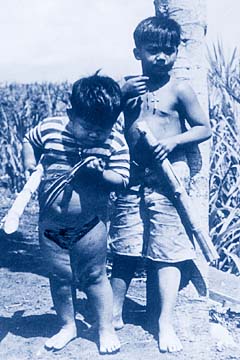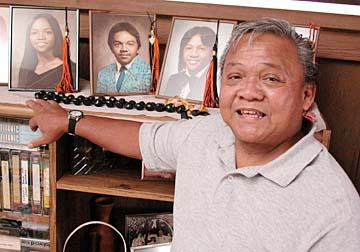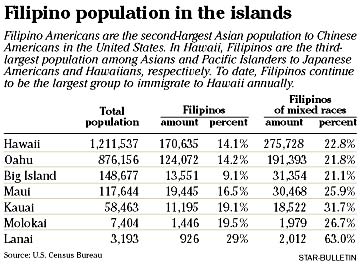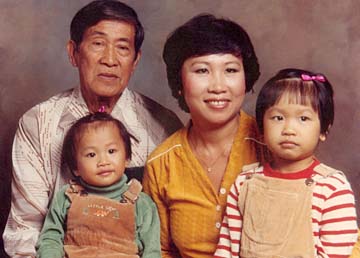THE SAKADAS: FROM THE FIELDS

|
Quidilla first earned 10 cents working 12 hours a day in the Waipahu cane fields, said his 22-year-old daughter, Sharon.
Enduring 43 years of back-breaking labor, Quidilla suffered from a stooped back and gnarled fingers, had a toe severed by a bin accidentally dropped on his left foot, and cauliflower ears inflamed by bundles of sugar cane being carried on his shoulders.

|
Officials hope to put stories like Quidilla's on display one day with those of other "sakadas" (Filipino plantation workers) at the new Filipino Community Center, opening Tuesday in Waipahu. It is just down the street from where Quidilla used to live and work.
The Filipino community credits the sakadas, who came to Hawaii in three waves of immigration, trailblazing the way for successive generations and giving them a chance to thrive in politics, education, sports and medicine.
Sharon Quidilla recalled how her father would often stress the importance of obtaining an education.
He would say, "Please, 'anako' (Tagalog for child), go to school, have an education. Don't be like me so you don't have to work hard like me," Quidilla said.
Quidilla died at the age of 91.
His words come alive in Sharon Quidilla, who is taking nursing classes at Kapiolani Community College, while her younger sister, Myra, obtained her bachelor's degree in accounting from Pacific University in Oregon last month.
"Our accomplishments are honoring what he did and what he had to go through," Myra said.
The growing population of Filipino Americans in Hawaii stems from three waves of migration to the islands. During a drop in Japanese immigration, about 120,000 Filipino plantation workers arrived in Honolulu between 1906 and 1934.
Under the Hawaiian Sugar Planters Association, 15 men arrived in Honolulu on the SS Doric from the Philippines on Dec. 20, 1906, to work as laborers in the plantation fields. The following year, about 150 laborers were recruited to the islands.

|
Plantations were owned and controlled by five companies, called the Big Five, which included Theo H. Davies, Alexander & Baldwin, Castle & Cooke, American Factors (now Amfac/JMB Hawaii) and C. Brewer & Co.
The Filipinos were the last in the line of ethnic groups to be recruited to work on plantations in the islands. First, there were the Chinese, then the Japanese, Portuguese and Puerto Ricans. Spanish and Korean laborers were also recruited to work in the plantation fields.
Workers were transported to the cane fields by truck or train to start work at 6 a.m. planting, fertilizing and harvesting sugar cane. Supervisors imposed 12-hour workdays among the laborers. At the sound of a whistle, an hour's lunch and rest period was given. Like many plantation workers, Quidilla packed his lunch in a tin can layered with rice, vegetables and meat. Base pay for plantation workers was about a $1 a day. Sharon Quidilla said a majority of her father's earnings were sent back to the Philippines to help family members get an education.
Rigorous labor caused Simplicio Quidilla to develop a hunched back from hauling bundles of stalks of sugar on his back into trucks. Many cane carriers also developed cauliflower ears from tiny thorns on cane's leaves that cut into the laborer's earlobe, leaving it permanently disfigured.
During his employment with Oahu Sugar, Simplicio lived in a Filipino plantation camp behind the post office in Waipahu.
All cane field workers were issued metal identification tags called bango in pidgin. Bango tags were also used as a credit card to buy clothing and household items at stores. Items would be recorded by the store clerk under their bango tag number.
In 1974, Quidilla retired as a machine operator at the age of 65 and returned to the Philippines for vacation, where he met and married Erlinda Jamon. The couple settled in Waipahu near the Oahu Sugar Mill.
Some Filipino laborers would work temporarily in Hawaii and return to their homeland after earning enough money.
Though a native of the Philippines, Simplicio Quidilla never wanted to live anywhere else but in Waipahu, said his daughter Sharon Quidilla.
"He wanted to stay close to the sugar mill. That was his life," she said.
Throughout the early plantation days, Filipinos were stereotyped as industrious but uneducated.
Dean Alegado, chairman of the Ethnic Studies Program at the University of Hawaii-Manoa, said recruiters would favor uneducated workers who would not rebel against their supervisors.
However, a man named Pablo Manlapit organized a movement calling for higher wages for Filipino plantation workers. In 1924, Manlapit organized a strike, but it ended with the deaths of 16 Filipino workers who were shot and four police officers who were beaten in Hanapepe, Kauai, on Sept. 9, 1924.

The Tydings McDuffie Act of 1934 limited the number of Filipinos allowed to enter the United States. However, HSPA and the Pineapple Growers Association were exempted from the provision after they declared a labor shortage. This spurred the second wave of Filipino plantation workers between 1946 and the early 1960s.
"The excuse was a labor shortage. ... In reality, they were replacement workers," Alegado said.
The growers associations brought in more than 7,000 men, women and children to break a strike of plantation workers requesting better wages and working conditions under the International Longshore and Warehouse Union.
However, the associations' efforts failed after the new recruits joined the strike.
In 1946 the federal government allowed Filipinos to be recruited in the military, and the quota of Filipino sailors was increased under the U.S. military bases agreement. Thereafter, Filipinos in the military would return to the Philippines, get married and later move to Hawaii.
This second wave brought 10,000 to 12,000 Filipino military personnel, war brides and laborers to Hawaii.
Ewa Beach resident Steven Tingkang recalls the financial struggles of living in a plantation camp during the 1950s. His father, Escolastico, worked as a laborer irrigating the sugar cane fields and "just made enough (for us) to survive," Tingkang said. Tingkang was raised in Kunia Camp No. 26 where he and his younger brother, Robril, walked 20 miles a day to and from Waipahu Elementary School.
Tingkang, now 67, reminisced how he and his younger brother, Robril, would peel sugar cane stalks with a pocketknife.
Vegetables such as beans, okra and bitter melon were planted in the cane fields.
Tingkang said he and his family later moved to a camp in Pearl City Heights where multiethnic groups lived together.
"There was no hatred. Everyone was neighborly. ... In order to survive, everybody had to get together," he said.

|
During the third wave, Filipino Americans started petitioning to bring their brothers, sisters, sons and daughters to Hawaii. Also, Filipino Americans with professional degrees began to stream into Hawaii. Since 1965 between 4,000 and 5,000 Filipinos immigrated to Hawaii annually, making Filipino Americans the fastest-growing population in the islands, Alegado said. It is also the second-fastest growing population in the nation, trailing those migrating from Mexico.
Throughout the years, several Filipino Americans have gained local and national attention from politics to sports.
In 1954, Peter Aduja was elected to the Territorial House of Representatives.
In 1962, Benjamin Menor became the first Filipino American to serve as a Hawaii state senator. Twelve years later, Menor became the first Filipino American in the nation to be appointed to a state Supreme Court.
In 1974, Eduardo Malapit of Kauai became the first mayor of Filipino descent in the nation.
In 1994, Gov. Ben Cayetano became the first Filipino to be elected governor in the United States. Oahu resident Angela Baraquio became the first Asian American to win the Miss America pageant in 2001. Seattle Times reporter Byron Acohido of Wahiawa won a Pulitzer Prize in 1997 for his report on rudder system problems in the Boeing 737.
In medicine, Dr. Jorge Camara became the first physician in Hawaii to use telemedicine for a surgical procedure and the first in the nation for ophthalmology. Waipahu resident Brian Viloria won the 1999 national title in featherweight boxing, and Benny Agbayani continues to be a notable player in Major League Baseball.
During this year's legislative session, a bill was passed to establish a Filipino Centennial Celebration Commission. Cayetano was scheduled to sign the bill into law today. Members of the commission would organize a celebration in 2006 acknowledging the 100th anniversary of the arrival of Filipinos in Hawaii.
"From those humble beginnings, we have almost a century of progress," Alegado said.
*courtesy/credit to Rosemarie Bernardo/StarBulletin.com/can read on wwwammuenpaydaytoysakada.blogspot.com
No comments:
Post a Comment